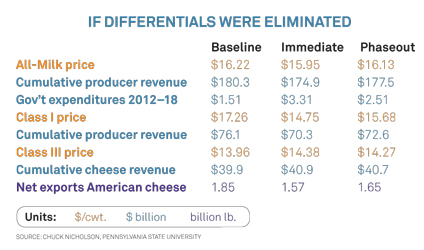Life with No Order(s)

What would dairying be like without Class I differentials?
The International Dairy Foods Association has proposed eliminating minimum prices immediately and phasing out Class I differentials over the next five years as part of its farm bill/dairy reform initiative.
While the idea was a nonstarter with dairy cooperatives, the industry continues to ruminate over what changes are needed within the Federal Milk Marketing Orders system.
|
| |
Chuck Nicholson, a dairy economist at Pennsylvania State University (formerly at Cal Poly), has done a preliminary "food for thought" analysis of what effect the elimination of differentials would have on milk prices, cumulative revenues (if milk prices go down, consumption goes up), exports and government expenditures.
He looked at two scenarios: the immediate elimination of differentials in July 2013 and a four-year phaseout beginning in July 2013. He compared both to the current baseline program.
He assumed that the Federal Orders would maintain minimum pricing for each class of dairy products, with the "higher of" Classes III and IV used to determine the Class I and II price within each order. His findings:
- "Eliminating differentials reduces the All-Milk price, slightly increases price variation and lowers revenues," Nicholson says.
His baseline All-Milk price comes in at $16.22 per cwt. An immediate elimination would drop that price to $15.95 and a phaseout would drop it to $16.13.
These are not large drops, but when applied to all milk produced, cumulative producer revenues drop from $180.3 billion to $174.9 billion for immediate elimination and to $177.5 billion for a phaseout. And this is on a national basis. Areas of the country with large Class I sales would be hit hardest.
- "Eliminating differentials has the potential to increase government expenditures under current programs due to lower average prices, especially during price troughs," Nicholson says.
He projects government expenditures under current programs to total $1.51 billion between 2012 and 2018. The immediate elimination of differentials would trigger government expenditures of $3.31 billion and a phaseout would cost $2.51 billion. Neither increase would make up for the loss in producer revenues from the loss of the differentials.
- "Eliminating differentials decreases Class I prices, increases fluid milk sales and decreases fluid milk revenues [due to lowering the price of an inelastic product]," Nicholson says.
The Class I price under the baseline would be $17.26 per cwt. compared to $14.75 with an immediate elimination of Class I differentials and $15.68 with a phaseout. Cumulative fluid revenues would fall from $76.1 billion to $70.3 billion with an immediate elimination and to $72.6 billion with a phaseout.
- "Eliminating differentials increases Class III prices, decreases cheese sales and increases cheese revenues," Nicholson says.
The Class III price would rise from a baseline of $13.96 per cwt. to $14.38 per cwt. with an immediate elimination of Class I differentials and $14.27 with a phaseout. Cumulative cheese revenues would increase by about $1 billion with immediate elimination and by $750 million with a phaseout. Cheese exports would also be reduced due to higher prices.
The bottom line, Nicholson says, is that Federal Orders still matter. "But the impact on producer revenue is smaller now, perhaps 1.5% to 3%, than it would have been in the past," he says.
Without Federal Orders, fluid milk consumers would be the big winners. But people who love cheese and ice cream would pay more.








